The Neurovascular System of Neovenator – A “Touchy” Subject
When it comes to European theropods, most are only known from a handful of fragmentary bones. An exception to this is the allosauroid Neovenator (N. salerii) from the Barremian faunal stage of the Early Cretaceous. Some seventy percent of the skeleton of an individual animal has been excavated from the Wessex Formation exposures on the Isle of Wight and crucially, this fossil material, the holotype, includes portions from the front of the skull.
Neovenator salerii
Although it has been some twenty years, since this dinosaur was formally named and described, the fossils, especially the cranial material, can still yield intriguing information about the capabilities and potential behaviour of carnivorous dinosaurs.
A Model of Neovenator (N. salerii)
Picture credit: Everything Dinosaur
The picture (above) shows a Neovenator from the CollectA Deluxe range.
To view this range: CollectA Prehistoric Animal Models – Deluxe.
Writing in the journal Scientific Reports, a team of researchers from Southampton University in collaboration with European colleagues, provide a detailed study using computed tomography of two bones from the front part of the skull that make up the upper jaw (premaxilla and maxilla).
The research reveals the presence of a substantial network of neurovascular canals which are linked to the external surfaces of the jaw bones. This suggests that Neovenator had a “sensitive face”, it might have been able to sense its environment, or perhaps the anterior portion of some theropod skulls played a tactile role in behaviour, dinosaurs rubbing noses for example, perhaps as a way of reinforcing bonds in a pack. The snouts of meat-eating dinosaurs could have had a functional role, similar to the same role that our fingertips perform for us primates. It is an intriguing thought.
The Skull of Neovenator Showing the Location of the Premaxilla and Maxilla Fossil Bones
Picture credit: Darren Naish
The Trigeminal Nerve
The research team took care to rule out the idea that these observed internal structures may have resulted from imaging errors arising from the scanning process. In addition, theropod skulls like many extant tetrapods, have lots of air spaces in the bones (skeletal pneumaticity), the researchers interpreted these canals and channels as being independent and separate from the pneumatic system. The branching structures that the team identified were concluded to be part of the neurovascular system, components the team identified were interpreted as constituents of the trigeminal nerve, sometimes referred to as the fifth cranial nerve.
This multi-branching nerve is responsible for tactile information, external temperature assessment, it has a role in motor control such as our chewing motion and provides pain receptors within the face. It seems that Neovenator had a sensitive snout.
The Articulated Premaxilla and Maxilla of Neovenator – Scan Reveals a Network of Neurovascular Structures
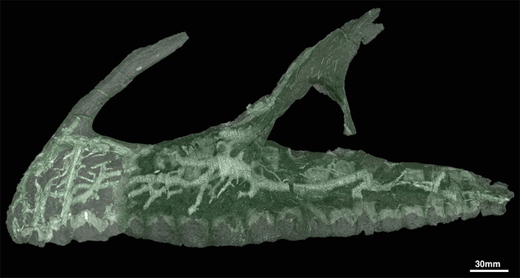
Articulated premaxilla and maxilla of Neovenator holotype MIWG 6348 in left lateral view showing neurovascular structures.
Picture credit: Barker et al University of Southampton
A Specialised Tactile Organ of Neovenator
When the size of these canals and structures were assessed they were calculated to occupy 7.3% of the volume of the premaxilla and 6.7% of the total volume of the maxilla. If this large theropod had a very sensitive face, then this leads onto the question regarding the role or function of such a sensitive area of skin. Some research has already been undertaken when it comes to the sensory abilities of large theropods. For example, the cranial morphology of Spinosaurus (S. aegyptiacus) has been studied, in particular the enlarged foramina (openings) associated with the surface of the premaxilla.
Spinosaurus is believed to have been an aquatic dinosaur, these enlarged and numerous foramina may have played a role in helping this dinosaur make sense of its aquatic environment. Crocodylians for instance, have very sensitive jaws, lined with tiny foramina that provide sensory information (integumentary sense organs), their exact role is uncertain but they probably play a role in prey detection and orientation.
The Long Jaws of Spinosaurus Could Have Provided Sensory Information
Picture credit: Everything Dinosaur
The picture (above) shows a Spinosaurus figure from the Safari Ltd range.
To view this range: Wild Safari Prehistoric World Models.
In addition, earlier this year, Everything Dinosaur published a short article summarising research undertaken on a newly described species of Tyrannosaur (Daspletosaurus), which may have had a sensitive snout: New Species of Daspletosaurus Announced – The Sensitive Side of Theropods.
Exploring the Sensory Capabilities of the Dinosauria
Commenting upon the significance of this new study, one of the co-authors of the scientific paper, Dr Darren Naish, (National Oceanography Centre, University of Southampton) stated:
“This is a pretty exciting study; the results were unexpectedly good and reveal a level of anatomical detail we hoped for but didn’t realise we’d actually get. Quite what this facial sensitivity means for the behaviour and biology of these animals is the big question – roles in feeding, foraging, nesting and social behaviour are all possible.”
Scan of the Anterior Portion of the Skull of Neovenator
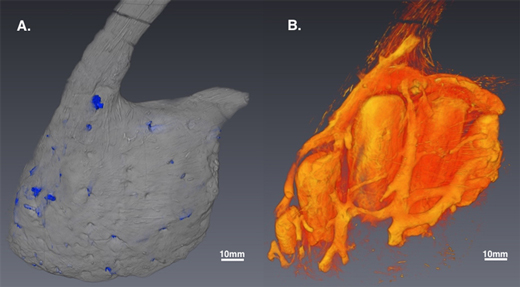
The complex neurovascular system observed in the premaxilla including the nervous system associated with tooth sockets.
Picture credit: Barker et al University of Southampton
Large, Complicated Facial Canals
The discovery of large, complicated internal canals within the bones of the anterior portion of theropod dinosaur skulls suggests that these were sensory organs providing an enhanced tactile function in conjunction with information about the dinosaur’s immediate environment.
This well-written paper poses a number of intriguing questions as to the function(s) of these structures. One of the ideas suggested is that a sensitive snout helped with the mechanical process of stripping flesh from a carcass, perhaps guiding the feeding to ensure that teeth did not impact with bone. Or maybe these structures played a role in thermoregulation, helping to keep the animal cool.
It also shows that a surprising amount of new data can be obtained by revisiting very well documented fossil material. The researchers conclude that extensive neurovascular facial structures may not have been limited to the spinosaurids and as such regarded as an adaptation to aquatic foraging. What roles they did play is open to speculation, enhanced facial sensitivity could be linked to a very wide range of behaviours such as precise feeding, social bonding, identifying individuals, nest selection, intraspecific combat and social interaction.
More Work is Needed
More work is required in this fascinating area of Dinosauria anatomy and our understanding of the facial neurovascular systems of extinct archosaurs would be aided with a better understanding of the facial neurovascular structures of living archosaurs such as the crocodylians and birds.
The scientific paper: “Complex neuroanatomy in the rostrum of the Isle of Wight theropod Neovenator salerii” by Chris Tijani Barker, Darren Naish, Elis Newham, Orestis L. Katsamenis & Gareth Dyke published as an open access paper in the journal Scientific Reports.
Paper is available here: Open Access Paper is here.
Visit the Everything Dinosaur website: Everything Dinosaur.


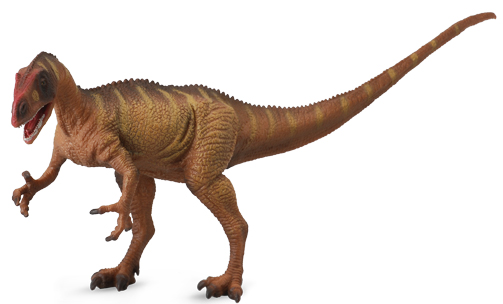
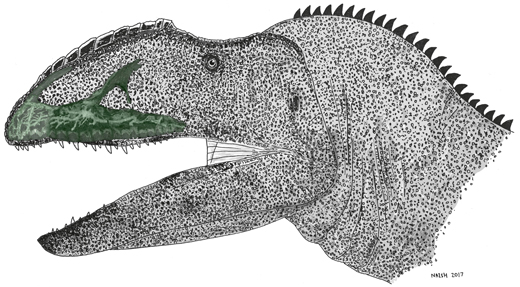
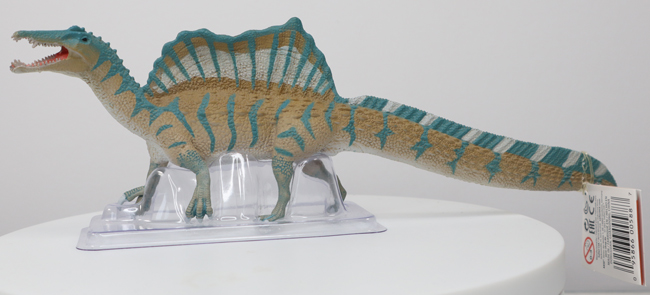




Leave A Comment